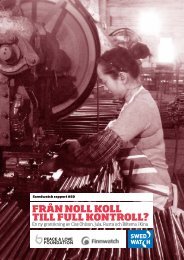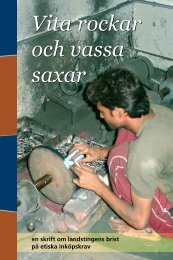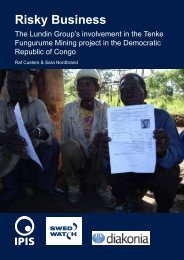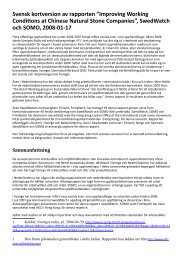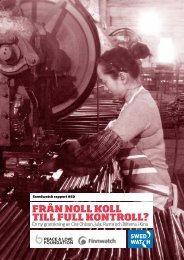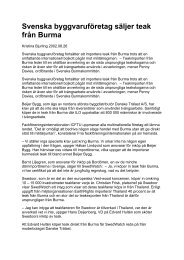4. Case study: Top Toy, Brio and Coop in China - Swedwatch
4. Case study: Top Toy, Brio and Coop in China - Swedwatch
4. Case study: Top Toy, Brio and Coop in China - Swedwatch
You also want an ePaper? Increase the reach of your titles
YUMPU automatically turns print PDFs into web optimized ePapers that Google loves.
of los<strong>in</strong>g the rema<strong>in</strong><strong>in</strong>g wages. The delayed payment of wages makes the economic situation<br />
of the migrant workers even more difficult.<br />
Anita Chan means that Ch<strong>in</strong>a is the country, which pushes down its wages to the lowest levels<br />
<strong>in</strong> the whole world 69 . Despite the <strong>in</strong>creas<strong>in</strong>g dem<strong>and</strong> for workers <strong>in</strong> the low-wage <strong>in</strong>dustries,<br />
the wages have not augmented. On the contrary some have gone down. The wages <strong>in</strong> Ch<strong>in</strong>a<br />
are very low compared to other develop<strong>in</strong>g countries 70 . When the m<strong>in</strong>imum wages were first<br />
<strong>in</strong>troduced dur<strong>in</strong>g the 1990's it was to protect the employed. Now Chan stipulates that their<br />
ma<strong>in</strong> aim is to keep down the wages <strong>in</strong> order to ma<strong>in</strong>ta<strong>in</strong> the competitiveness.<br />
– In 1996 the workers <strong>in</strong> Shenzhen earned 58 – 68 Euro 71 per month <strong>and</strong> now eight years later<br />
they still earn as little. The better plants might pay almost 94 Euro, but only dur<strong>in</strong>g the peak<br />
season <strong>and</strong> then the workers need to do very long work<strong>in</strong>g days. My conclusion is that the<br />
economic expansion has not been of much benefit to the workers, says Anita Chan.<br />
The m<strong>in</strong>imum wages have <strong>in</strong>creased, but not regard<strong>in</strong>g the real wages. Accord<strong>in</strong>g to the<br />
Ch<strong>in</strong>ese government, the m<strong>in</strong>imum wages shall be fixed to 40-60 percent of the average<br />
wages <strong>in</strong> the region where the m<strong>in</strong>imum wages are <strong>in</strong> force. But <strong>in</strong> Shenzhen the m<strong>in</strong>imum<br />
wages decreased from 40 percent of the average wages <strong>in</strong> 1993 to below 24 percent<strong>in</strong> 1999.<br />
This means greater <strong>in</strong>come cleavages between the urban population <strong>and</strong> the guest workers.<br />
Anita Chan shows that Shenzhen <strong>and</strong> Guangzhou have the lowest m<strong>in</strong>imum wages <strong>in</strong> the<br />
whole of Ch<strong>in</strong>a, <strong>in</strong> comparison to the average wages <strong>in</strong> these areas. Also Elisabeth Tang,<br />
Chief Executive at HKCTU 72 , confirms that the wages of the plant workers <strong>in</strong> Guangdong<br />
have been close to stagnant dur<strong>in</strong>g the last years despite the <strong>in</strong>crease of the prices six – ten<br />
folds.<br />
– The basic problem is that the workers cannot form their own unions; freedom of association<br />
is not implemented <strong>in</strong> Ch<strong>in</strong>a. So you can imag<strong>in</strong>e, we have the world’s biggest workforce,<br />
which is completely unorganised. It is only controlled. The workers have to keep quiet about<br />
their problems, says Elisabeth Tang.<br />
25






